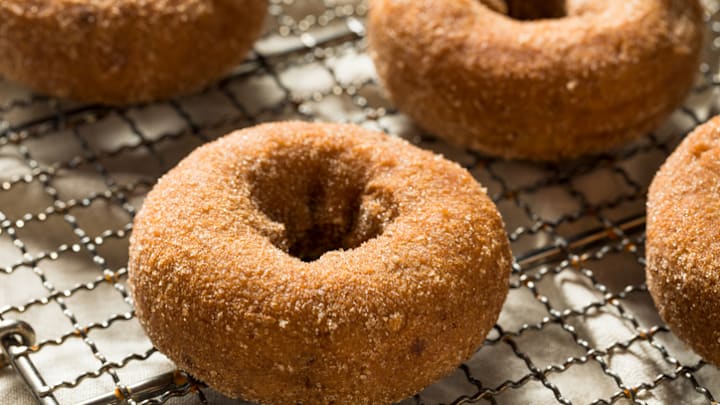You don't have to be a Great British Baking Show obsessive to know that everyone loves doughnuts. And if you grew up on the East Coast, you've probably indulged in your fair share of apple cider doughnuts. Apple cider doughnuts are synonymous with fall, particularly in New England, where apple orchards from Maine to New York use their own cider to flavor the fluffy, golden rings. Both sweet and savory, and often dusted in finger-licking cinnamon sugar, apple cider doughnuts may seem like a quaint tradition inherited from colonial times—but the tasty treats have a more modern history that may surprise you.
Origin of the Doughnut
It all started with Russian immigrant and entrepreneur Adolf Levitt. According to Glazed America: A History of the Doughnut, Levitt bought a chain of New York bakeries in 1916. He was impressed by American soldiers’ fondness for the fried loops of flavored dough and began developing a doughnut-making machine to take advantage of troops’ appetites. In one of his early marketing coups, he installed a prototype in the window of his Harlem bakery in 1920. The machine caught the eye—and the cravings—of passersby. Levitt went on to sell his doughnut-making machines and a standardized flour mix to other bakeries.

He spun his marketing prowess into founding the Doughnut Corporation of America. The corporation evangelized doughnuts in marketing campaigns across print media, radio, and TV. A World War II-era party manual the DCA produced noted, “no other food is so heartwarming, so heartily welcomed as the doughnut.” Levitt’s granddaughter Sally L. Steinberg wrote that Levitt “made doughnuts America's snack, part of office breaks for coffee and doughnuts, of Halloween parties with doughnuts on strings, of doughnut-laden political rallies.”
Doughnuts Get a Refresh
The DCA launched the first National Doughnut Month in October 1928. In its zeal, the DCA sometimes made dubious recommendations. In 1941, along with surgeon J. Howard Crum, it advocated for the single source “doughnut diet.” Later it marketed “Vitamin Doughnuts” based on an enhanced flour mix it claimed provided more protein and nutrients than made-at-home creations. (The federal government required them to use the name “Enriched Flour Doughnuts,” according to Glazed America.) A skeptical public didn’t gobble up the sales pitch—or the doughnuts.
You May Also Like:
- Each State’s Favorite Doughnut, Mapped
- Where Does That Stereotype About Cops and Doughnuts Come From?
- Science Has a Good Explanation For Why You Can't Resist That Doughnut
Add Mental Floss as a preferred news source!
Enter the Apple Cider Doughnut
In 1951, however, the DCA introduced a flavor with staying power. A New York Times article from August 19 of that year observed, “A new type of product, the Sweet Cider Doughnut will be introduced by the Doughnut Corporation of America in its twenty-third annual campaign this fall to increase doughnut sales. The new item is a spicy round cake that is expected to have a natural fall appeal.”

The cider doughnut recipe gives a fall spin to the basic buttermilk doughnut by adding apple cider to the batter, with cinnamon and nutmeg boosting the autumnal flavor. Each orchard typically has its own family recipe and usually serves them paired with mulled apple cider. The doughnuts have caught on well beyond pastoral landscapes and are now seasonal favorites in national chains and home kitchens. Dunkin’ has taken up the mantle, and Smitten Kitchen and The New York Times have recipes for make-at-home versions.
Although the apple cider doughnut has stood the test of time, the DCA didn’t. J. Lyons & Co. bought out Levitt’s DCA in the 1970s, and the entrepreneurs behind Seattle’s Top Pot Doughnuts later bought the DCA trademark. The company distributes its doughnuts nationwide; however, its offerings don’t include a cider doughnut.
A version of this story was published in 2020; it has been updated for 2025.
